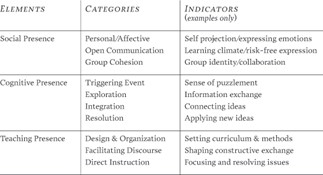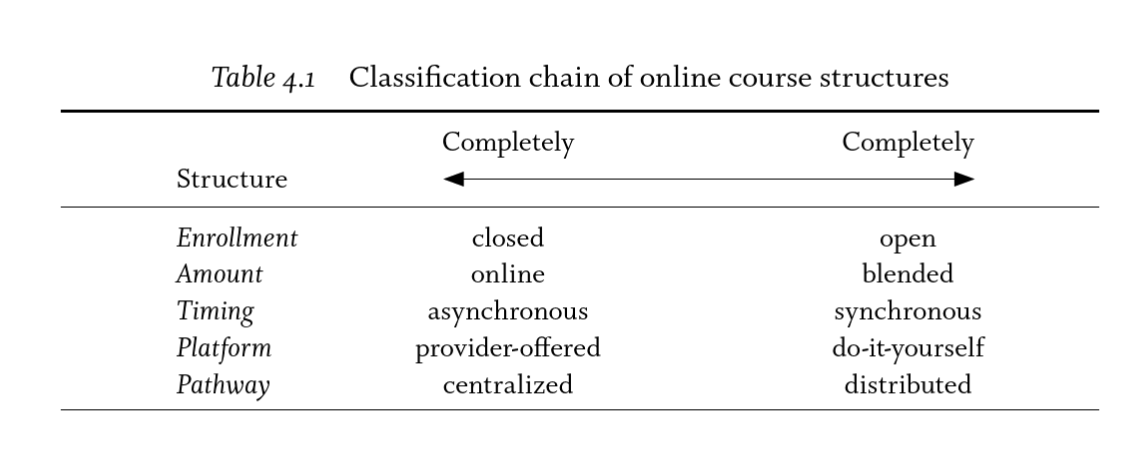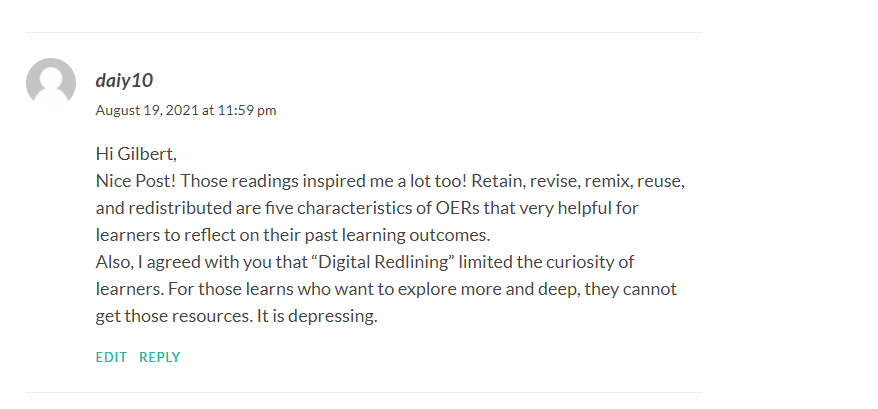Digital Portfolio
During Topic 1, I did the discussion and learning on the technology of education and the challenges within it. This is my first step to understanding the learning environment.
Regan, P., & Jesse, J. (2019). Ethical challenges of edtech, big data and personalized learning: Twenty-first century student sorting and tracking.
This reading concluded the challenge and concern from the education system based on the statement by Regan and Jesse(2019):
“The six “privacy” concerns are information privacy; anonymity; surveillance; autonomy; non-discrimination; and ownership of information.”
Now I get to know the concern that raises privacy concerns when human-centered learning in distributed learning and open learning.
I expressed my point of view in my post, which mostly focuses on non-discrimination and information privacy.
https://kamisato.opened.ca/edci-339-topic-1 /
When facing discrimination on learning, I said “The potential of an individual does not depend on their race or gender. Big data cannot calculate the capacity and energy within an individual; with enough effort, every possibility might be created by a person. Also, we need diversity and inclusion of education from all types of people instead of discrimination based on stereotypes of different types of people”.
In addition, our personal information might be stolen and used in some illegal activities. I share a personal experience on the post which is involved with information privacy.
I commented on my pod “It is indeed a serious problem when people are depended on advanced function on access like “face id” and “fingerprint” which also can create new security issue of personal information.”
A strong comment was presented by my classmate which I agree with, Joseph suggested that when schools are looking to implement educational technologies that they use a committee of diverse experts rather than relying on one or two individuals in power to make decisions.
Vaughan, N. D., Garrison, D. R., & Cleveland-Innes, M. (2013). Teaching in blended learning environments: Creating and sustaining communities of inquiry.
In this reading, I highlight the chart and the picture of a community of Inquiry framework.


From doing this, I learned the serious concerns on privacy. It is an alert when the distributed learning and open learning are applied to my future learning. Also, I learned the basic framework of a blended learning environment from the reading. The three elements social, cognitive and teaching are important to contribute to a theoretical teaching environment of the community of inquiry.
This learning contributed to my development of Describe the potential of human-centered learning in distributed and open learning contexts
This learning matters to me because it is like a door for me to access the understanding of distributed learning and open learning. These reading and discussion expand my thinking on the application in a learning environment.
During the Topic 2, I did the discussion and learning on the history of open learning and teaching online strategy.
Reading list:
Major, C. H. (2015). Teaching Online – A Guide to Theory, Research, and Practice. Retrieved from http://ebookcentral.proquest.com/lib/uvic/detail.action?docID=3318874 (pp. 76-108)
“Another form of social media is an immersive world, 29 such as Second Life, 30 Activeworlds, 31 or OpenSimulator. 32 Instructors and students typically take up an avatar (a graphic repre sen ta tion of the user) within a virtual space and interact with each other, so they have proximity to other individuals within the same virtual space at the same time.”
“Another form of social media is an immersive world, 29 such as Second Life, 30 Activeworlds, 31 or OpenSimulator. 32 Instructors and students typically take up an avatar (a graphic repre sen ta tion of the user) within a virtual space and interact with each other, so they have proximity to other individuals within the same virtual space at the same time.”
I highlighted the chart that clarifies Polaris on different elements of the structure.

Jordan, K. & Weller, M. (2017). Openness and Education: A beginners’ guide. Global OER Graduate Network.
“The Open Education in schools (or Open Classrooms) movement is the
earliest cluster present in the network, receiving greatest focus in the early 1970s.”
“The theme of distance education emerges in the network from 1980
onwards, with a focus on the growing phenomenon of open and distance universities.”
“E-learning and online education rose to prominence in the 1990s and early
2000s, bridging the gap between distance education and OER.”
“Open access publishing entered the network as a concept towards the end of
the 1990s, with a focus on metrics and how OA compares to traditional
scholarly publishing during the 2000s.”
“The OER theme emerges around the year 2000, initially focusing upon learning objects, open-source education, and OpenCourseWare.”
In my topic 2 post, I state the difference between cMOOCs and xMOOCs and the reflection on my learning environment.
https://kamisato.opened.ca/97-2/
“From the number of learners, I believe the cMOOCs are designed for contributed learning and xMOOC is for open learning. It is because the method and targeted learner differ by the connection between each person.”
I found out YiFei points out an interesting point about centralized and decentralized pathways when applying to our learning environment.

I commented on this post: “I agree with your point on centralized and decentralize pathways are more straightforward for the connection between course-related material and students.”
From doing this, I learned the important components that build the structure of an online course which consist of enrollment, amount, timing, platform, and pathway. I get to know the foundation that provides the platforms for open learning environments like social media. The reading gave me several successful experiences of teaching online from professors and experts. Also, I get to know the history of open learning and its movement and development in these 40 years. I learned what OER is and how it can benefit our learning.
This learning contributed to my development of exploring and engaging with current literature on the distributed and open education movement and critically reflect on and articulate concepts around modality, pedagogy, and access, including distributed and open learning theory, online and open learning history, privacy laws, online learning communities, open research, and open data. The teaching online experience inspired me to conduct research into and critically reflect upon emerging and future educational technologies.
This learning matters to me because if I want to develop a teaching career in the future, I would like to choose social media as a platform. I want to post the knowledge on web and share my thoughts on public and it can give a wide space for discussion and comment by people.
During the Topic 3 and 4, I did the exploring and discussing the concept of open pedagogy and further learning about privacy and access.
Reading list:
Mays, E. (Ed.). (2017). A guide to making open textbooks with students. Rebus Community.
“OERs are educational materials that are openly-licensed, usually with Creative Commons licenses, and therefore they are generally characterized by the 5 Rs[5]: they can be reused, retained, redistributed, revised, and remixed.”
“OEP, or Open Educational Practices, can be defined as the set of practices that accompany either the use of OERs or, more to our point, the adoption of Open Pedagogy.”
Gilliard, C., & Culik, H. (2016, May 24). Digital Redlining, Access, and Privacy. Common Sense Education.
“At the community college where we teach — as at many community colleges nationwide — where digital resources are scarce and the students and faculty are embedded in working class realities, digital redlining imposes losses that directly limit the futures of our students.”
“If the school restricts information access, knowledge doesn’t simply become invisible; it does not exist. The filter—a tool configured by policy and implemented by an individual’s interpretation of that policy—digitally redlines the intellectual territory of the community college students in ways not seen at “higher level” institutions where the working class does not predominate.”
On my topics 3 and 4 posts, I stated the advantage of open pedagogy that breaks the barrier of access for learners and how OER-enabled pedagogy qualifies teaching and learning practice. Also, I argued about the barrier of access and privacy from the student cases of reading.
https://kamisato.opened.ca/edci-299-topic-3-reading/
https://kamisato.opened.ca/edci-339-topic-4/
Digital Equity and Perspective pod project
https://edci339pod5.opened.ca/
By doing this project, I understand the difference between the distributed learning and open learning. We compared these learning environments based on the elements: access, timing, engagement, and platform. We designed the learning environment for our persona regarding the barrier and challenges within.
“Instead of living sessions, asynchronous courses offer flexibility on time arrangements for his convenience. At the University of Victoria, Brightspace is a platform for students to access online courses during tough times.”
“First of all, he needs to achieve credit by completing the program from university, and credit and work experience are necessary for his teaching career in the future. To be more specific, the contribution of a student’s work is hidden by the school system”
From doing this, I learned how OERs are applied into an open learning environment, and openly licensed system on online teaching. I learned the advantage of using a platform like open pedagogy and why it is a good option for open learners. From doing the pod project, I learned which learning environment fits me best and which one I would like to choose for a future teaching career. OERs also provides lots of great advice on teaching strategy so I can apply them on building a course for the certain learning environment.
This learning contributed to my development of Explore and engage with current literature on the distributed and open education movement, critically reflect on and articulate concepts around modality, pedagogy, and access, including distributed and open learning theory, online and, privacy laws, online learning communities, open research, Practice digital, networked, and open literacies in support of learning about distributed and open learning.
This Learning matters to me because it inspires me on critical thinking on choosing the learning environment which best fits our personal scenario. I need to consider the access issue and how the teaching method would apply to courses.
“Showcase” blog post
Original post: https://kamisato.opened.ca/edci-299-topic-3-reading/
Updated post: https://kamisato.opened.ca/topic-3-new-version/

Yifei’s comment inspires me to think deeper about the five characteristics of OERs. What are they stand for? What are the meanings behind them? How can they improve the open education system? After reading the topic 4 article, it explains all questions that I ever had. Therefore, I add some clarification about these five terms which gives me a more complete understanding of open education.
Leave a Reply